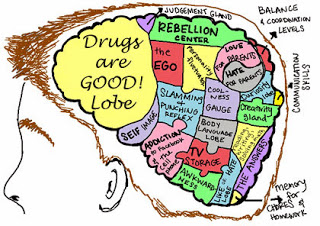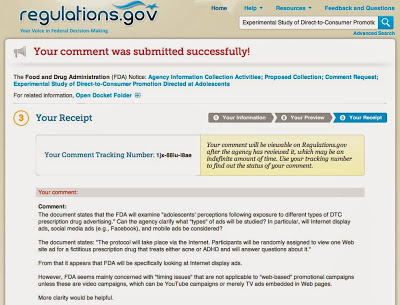For nearly 4 years now, we pharma marketing aficionados and FDA watchers have been anxiously awaiting the promised guidelines on regulating pharmaceutical promotions on the Internet and social media. Most of us believe we will never see these guidelines in our lifetimes (see here).
My “FDAdar” was aroused, therefore, when I read a Bloomberg story (here) that bluntly stated “[A proposed FDA study of teens and direct-to-consumer (DTC) advertising] will help determine whether some drugs may require more care when advertising online [my emphasis], the FDA said.”
I searched the document announcing this study in the Federal Register (here) and could not find the word “online” mentioned.
But wait! Upon further careful reading of the FDA study design protocol, I found this…
“Each participant will view a web-based promotional campaign [my emphasis] for either a fictitious Attention Deficit Hyperactivity Disorder (ADHD) medication or a fictitious acne medication.”
and
“The protocol will take place via the Internet. Participants will be randomly assigned to view one Web site ad for a fictitious prescription drug that treats either acne or ADHD and will answer questions about it. The entire process is expected to take no longer than 30 minutes. This will be a one-time (rather than annual) collection of information.”
So that sounds definitely like “online.” But wait! Right after that, the FDA provides more details of what it will look for:
“Within the two medical conditions, we propose to explore the role of three different factors that may influence adolescent understanding and perceptions of DTC. Two of these factors include timing issues: the timing of the onset of benefits and the timing of the onset of risks. Adolescents may be particularly likely to give more credence to benefits that occur immediately and may be likely to discount risks that do not occur immediately. Research suggests that the frontal lobe, which controls self-regulatory functions, is not fully developed until the mid-20s, which may lead to difficulty in impulse control and planning, and thus decision-making.”
“Timing issues” are not applicable to “web-based” promotional campaigns unless these are video campaigns, which can be YouTube campaigns or merely TV ads embedded in Web pages, which do not require new online-specific guidelines.
The Bloomberg reporter sent me this response after I made an inquiry:
Bloomberg Reporter: “If you search the word ‘care’ it’s on page 6. They just say advertising to adolescents. The article is about adolescents so we didn’t reiterate that and FDA is showing them websites of fake drugs for the study.”
Me: “You mean the statement: ‘…this information will be crucial in determining what types of prescription drugs may require additional care when advertising them to adolescents.’? The fact that FDA will use computers [the Web] to show study subjects DTC ads (which are probably video/TV ads) does not mean that FDA will determine from this study how pharma online ads ***specifically*** will require more care. Most online ads do not present information in a ‘timed’ fashion as FDA alludes to in the study design. I contend, therefore, that the FDA is specifically thinking of TV ads here.”
Bloomberg Reporter: “You could be right. We just did a quick riff off the document, didn’t talk to fda for this one.”
Me: [Huh?! I thought. But I wrote …] “I understand. I work in a world where if we see the words ‘FDA,’ ‘advertising,’ and ‘online’ in the same sentence, our FDAdar/Ears perk up! :-)”
So, false alarm! This study does not necessary mean that FDA will be issuing guidelines for online ads focused on teens, although they may issue guidelines for video/TV ads focused on teens.
But, you never know. The FDA document also says the study will examine “adolescents’ perceptions following exposure to different types of DTC prescription drug advertising” [my emphasis]. I’m not sure if FDA includes Internet, social media, and mobile ads in its thinking about “types of DTC prescription drug advertising.”
ADDENDUM: Back in February, 2007, I wrote: “FDA is concerned about unsafe drugs purchased through the Internet. Maybe they should also worry about drugs being advertised to teenagers on the Internet, especially drugs like ED medications and sleep aids, which have not been tested in children under 18” (see “Marketing Drugs to Teens Online – So Wrong!“).
At the time, I wasn’t thinking about how teens process benefit vs. risk information. I just thought it was wrong to market certain drugs to teens via the Internet and also on TV. FDA’s proposed study broadens the issue to drugs specifically approved for adolescents.
ADDENDUM: 7 Nov 2013. I asked John Mack, Publisher of Pharma Marketing News, to submit a comment to Docket FDA-2013-N-1151-0001 (here) asking for qualification regarding the “types” of DTC ads to be studied. Hopefully, it will get published to the Docket. Here’s the receipt for the record:










![6 Digital Tools at the Center of Healthcare Digitalization [INFOGRAPHIC]](http://ec2-54-175-84-28.compute-1.amazonaws.com/pharma-mkting.com/wp-content/uploads/2021/04/6DigitalTools_600px-100x70.jpg)




